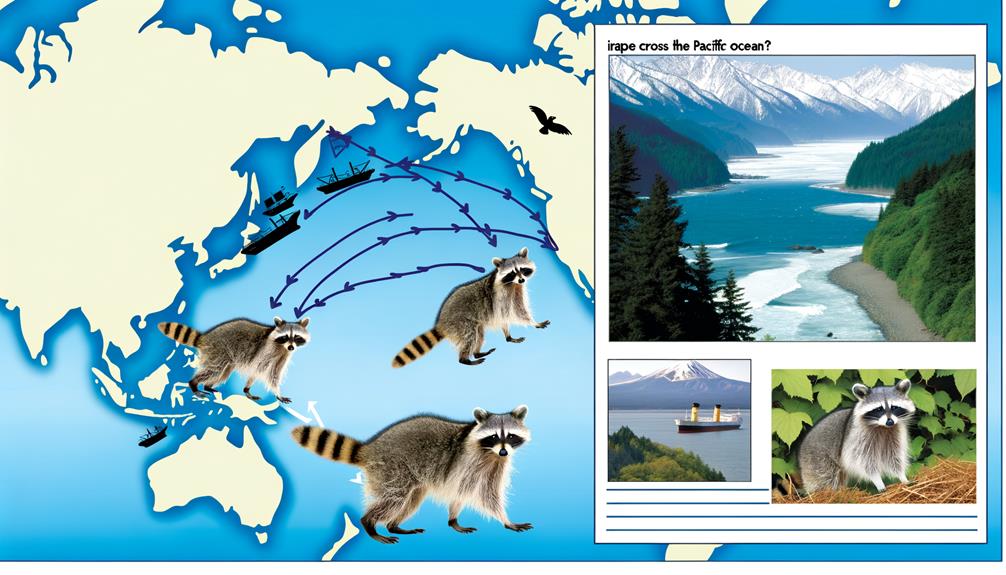Did Raccoons Get to Japan: A Step-by-Step Guide
Raccoons were introduced to Japan largely due to the anime 'Araiguma Rascal', which aired in the 1970s and fueled public fascination with these animals. This led to a significant rise in demand for raccoons as pets.
Consequently, thousands of raccoons were imported annually, facilitated by relaxed trade regulations. Many pet raccoons were later abandoned or escaped, establishing themselves in the wild.
These non-native raccoons have since posed ecological challenges, affecting local biodiversity and agricultural practices. To understand the full extent of their impact and the management efforts in place, further exploration into this topic is recommended.

Key Takeaways
- The anime 'Araiguma Rascal' significantly increased the demand for raccoons as pets in Japan.
- Relaxed import regulations facilitated the trade and importation of raccoons into Japan.
- Thousands of raccoons were imported annually due to their popularity as exotic pets.
- Public fascination with raccoons led to a surge in their ownership and subsequent release into the wild.
- Escaped or abandoned pet raccoons established populations in various Japanese habitats.
Origin of Raccoons
The origin of raccoons (Procyon lotor) can be traced back to North America, where they evolved approximately 5 million years ago during the Pliocene epoch. These adaptable mammals belong to the Procyonidae family and exhibit a range of characteristics that have allowed them to thrive in diverse environments.
Raccoons possess dexterous front paws, acute night vision, and a varied omnivorous diet, which includes fruits, nuts, and small animals. Their adaptability is further evidenced by their ability to inhabit both urban and rural areas.
Genetic studies indicate that raccoons' evolutionary lineage diverged from other procyonids, such as coatis and kinkajous, leading to the distinct species we recognize today. Understanding raccoon origins is essential for comprehending their ecological impact and behavior patterns.
The Rise of 'Araiguma Rascal'
Although raccoons are not native to Japan, the introduction and subsequent popularity of the animated character 'Araiguma Rascal' in the 1970s greatly influenced public perception and led to an unexpected ecological impact.
The anime, based on the novel 'Rascal, A Memoir of a Better Era' by Sterling North, captivated audiences and portrayed raccoons as endearing and intelligent creatures. This cultural phenomenon spurred a fascination with raccoons, leading to increased demand for them as pets.
Consequently, some raccoons escaped or were released into the wild, where they adapted and proliferated. This unplanned introduction has had significant ecological consequences, including competition with native species and potential disruption of local ecosystems. Understanding this cultural genesis is vital for managing the current raccoon population in Japan.
Importation as Pets
Driven by the increasing popularity of 'Araiguma Rascal', the importation of raccoons as pets into Japan surged dramatically during the late 20th century. This trend was fueled by the emotional appeal of the animated series, which depicted raccoons as endearing and manageable companions.
Importers capitalized on this demand by increasing the trade of Procyon lotor, facilitated by relaxed regulations and limited public awareness of the species' ecological impact. Customs data from the period reveal a significant uptick in raccoon imports, with thousands entering Japan annually.
This influx created a growing market for raccoon-related products and services, inadvertently setting the stage for future ecological challenges. The attraction of exotic pets played a crucial role in raccoons' introduction to Japan.
Challenges of Raccoon Ownership
Owning raccoons in a domestic setting presents numerous challenges, primarily due to their complex behavioral patterns and specific environmental needs. Raccoons are highly intelligent and possess a strong instinct for foraging, leading to potential destructiveness within a household environment.
Their nocturnal nature can disrupt human activity cycles, and their strong, dexterous paws enable them to open doors and cabinets, posing safety risks. Additionally, raccoons require a varied and nutritionally balanced diet, which can be difficult to replicate in captivity.
Health concerns also arise, as raccoons are potential carriers of zoonotic diseases such as rabies and leptospirosis. Ensuring adequate mental and physical stimulation is essential, yet often difficult, further complicating raccoon ownership.
Release Into the Wild
The release of raccoons into the wild in Japan presents complex ecological and ethical considerations, requiring thorough evaluation of environmental impact and species interactions. Initially introduced as exotic pets, many raccoons were abandoned or escaped, leading to their establishment in various habitats. This phenomenon raises significant concerns about biodiversity conservation and ecosystem stability.
Ethical issues arise from the responsibility of human actions in introducing non-native species, potentially disrupting local flora and fauna. Effective management strategies, including monitoring populations and implementing control measures, are vital. Collaborative efforts among government agencies, conservationists, and the public aim to mitigate adverse effects and guarantee the protection of native species while addressing the welfare of the raccoons themselves.
Ecological Impact in Japan
Understanding the ecological impact of raccoons in Japan necessitates an examination of the ways in which these non-native species interact with local ecosystems, potentially leading to alterations in native biodiversity and habitat dynamics.
Raccoons, introduced to Japan primarily as pets, have since established feral populations. Their opportunistic feeding behavior results in significant predation on native species such as birds, amphibians, and invertebrates, thereby disrupting food webs and ecological balances.
Additionally, raccoons can damage agricultural crops, impacting local farming communities. The presence of raccoons also poses a risk of disease transmission to native wildlife and humans, further complicating management efforts.
Consequently, the integration of raccoons into Japanese ecosystems presents multifaceted challenges that require targeted conservation and management strategies.
Adaptation to New Environment
Adaptation processes of raccoons in Japan involve behavioral and physiological changes that allow these non-native mammals to exploit various ecological niches within urban and rural landscapes.
Behaviorally, raccoons have demonstrated remarkable versatility, foraging in diverse environments ranging from agricultural fields to urban waste bins. These opportunistic feeders have also altered their activity patterns to become more nocturnal, reducing human-wildlife conflict.
Physiologically, raccoons have shown resilience in the face of Japan's varied climate, from humid summers to cold winters. They grow thicker fur in colder months and utilize human structures for shelter.
Such adaptations underscore the raccoon's ability to thrive in disparate environments, posing challenges to local biodiversity and necessitating informed management strategies.
Current Status and Management
The management of raccoons in Japan currently involves a multi-faceted approach. This strategy focuses on population control measures, thorough habitat impact studies, and extensive public awareness campaigns.
Population control efforts include trapping and sterilization programs aimed at reducing the number of raccoons in urban and rural areas.
Concurrently, habitat impact studies are being conducted to assess the ecological consequences of raccoon presence.
Public awareness initiatives seek to educate citizens on the importance of coexisting responsibly with this invasive species.
Raccoon Population Control
In order to mitigate the ecological and agricultural damage caused by the invasive raccoon population in Japan, current management strategies employ a combination of trapping, sterilization, and public awareness campaigns.
Trapping is utilized to capture raccoons, which are then subjected to sterilization procedures to curb reproduction rates.
This is complemented by public awareness campaigns that educate citizens on the importance of not feeding raccoons and reporting sightings to authorities.
These efforts are scientifically monitored to evaluate effectiveness and adjust methodologies as needed.
Additionally, collaboration with local communities and government agencies guarantees a coordinated approach.
This integrated management plan aims to balance ecological preservation with humane treatment of the raccoons, ensuring sustainable long-term results.
Habitat Impact Studies
Recent habitat impact studies have meticulously documented the ecological disruptions caused by the invasive raccoon populations in various regions of Japan. These studies reveal significant negative effects on native species, biodiversity, and agricultural productivity. Key findings include the predation of local fauna, competition with indigenous species for resources, and destruction of crops.
| Impact Type | Description |
|---|---|
| Predation | Increased predation on birds, amphibians, and insects |
| Resource Competition | Competition with native species for food and habitat |
| Crop Damage | Significant destruction of agricultural produce |
| Disease Transmission | Potential spread of zoonotic diseases to humans and animals |
Ongoing management efforts focus on controlling the raccoon population through trapping and public awareness initiatives, aiming to mitigate these adverse impacts.
Public Awareness Campaigns
Public awareness campaigns have become a pivotal element in the all-encompassing strategy to manage and mitigate the adverse ecological impacts of raccoon populations in Japan. These campaigns aim to educate the public about the environmental consequences of raccoon proliferation, including the disruption of native species and ecosystems.
Utilizing various media platforms, these initiatives disseminate information on proper waste management, the risks of feeding raccoons, and the importance of reporting sightings to local authorities. Additionally, community workshops and school programs are implemented to foster a collective responsibility towards wildlife management.
Conclusion
The introduction of raccoons to Japan, primarily driven by the popularity of 'Araiguma Rascal' and subsequent pet importation, has led to significant ecological disruptions. Challenges in raccoon ownership resulted in widespread releases into the wild, where these non-native species have thrived, akin to an invasive vine overtaking a garden.
The current management efforts focus on mitigating their ecological impact and controlling their population to protect native flora and fauna. In-depth strategies are essential for effective long-term management.






